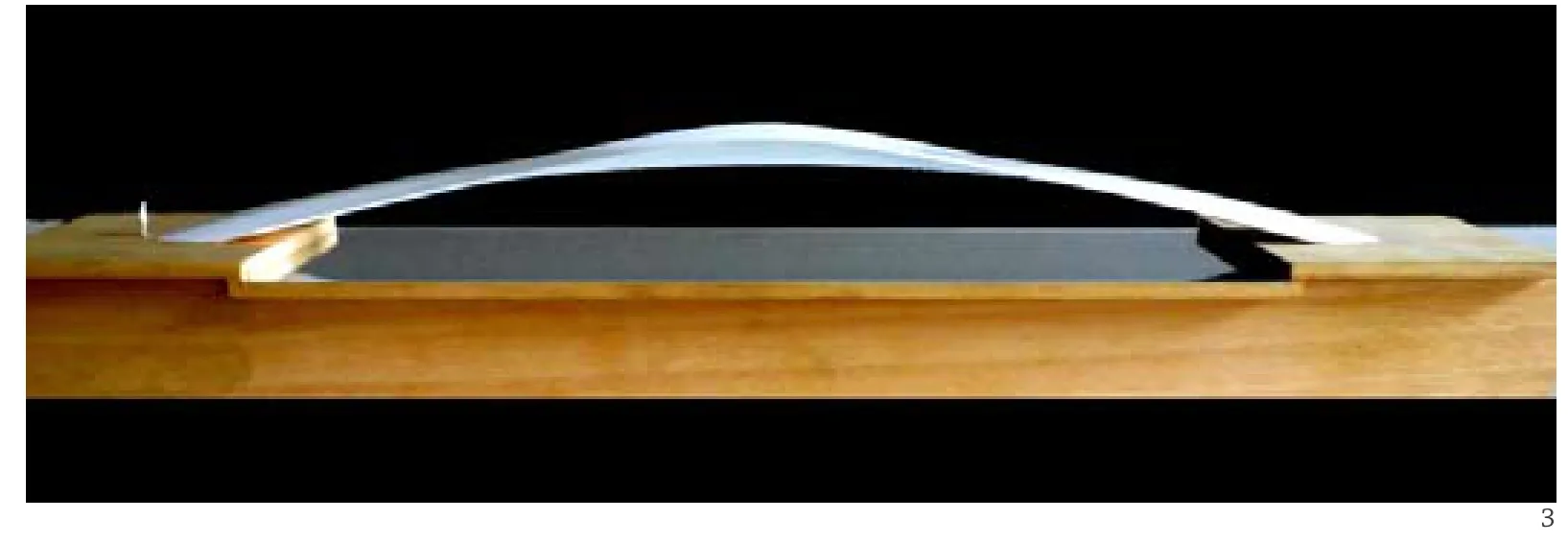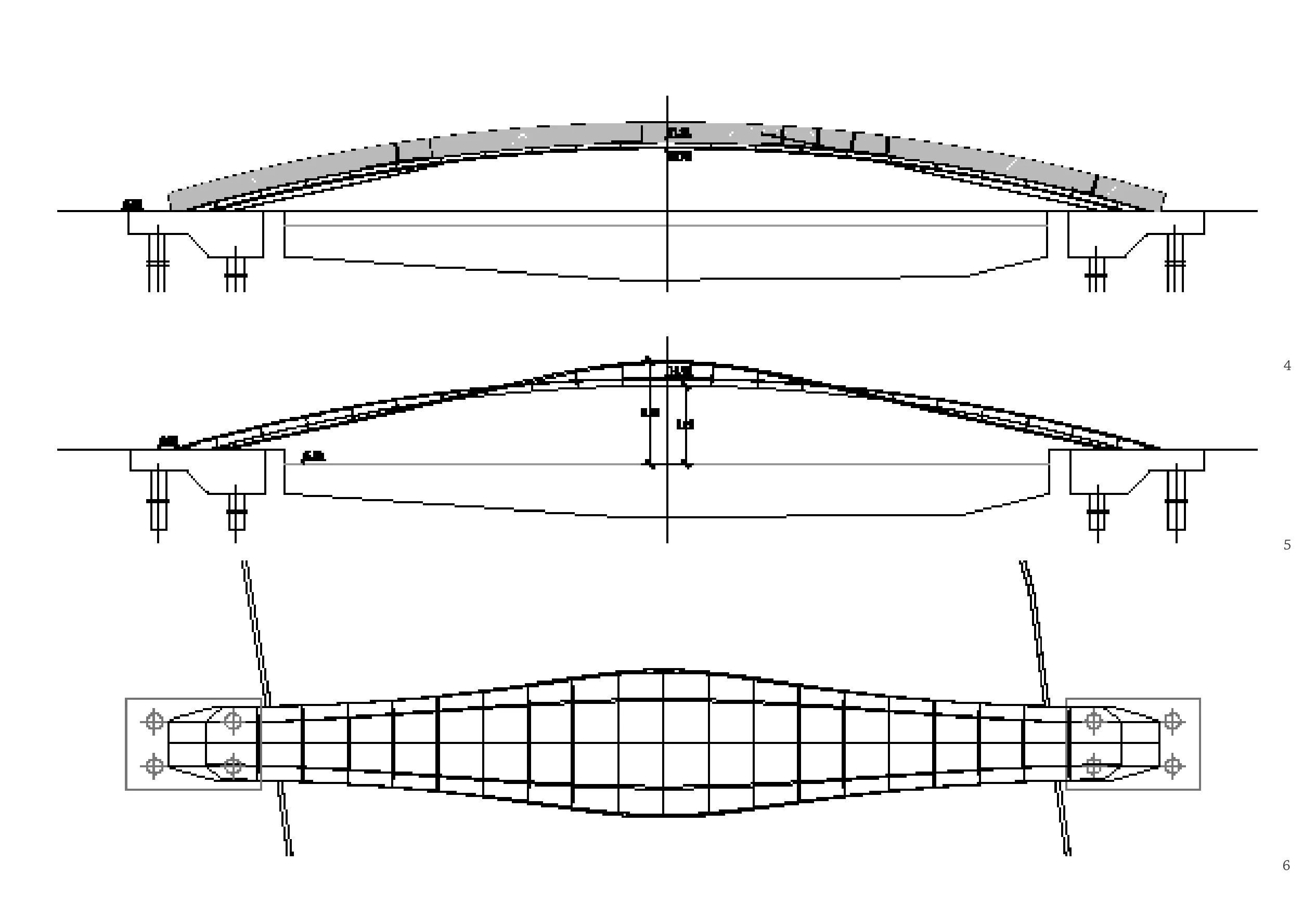柳叶桥,扬州,中国
2016-04-11建筑设计工程设计马克曼朗ArchitectEngineerMarcMimram
建筑设计/工程设计:马克·曼朗Architect/Engineer:Marc Mimram
柳叶桥,扬州,中国
Liu Ye Footbridge,Yangzhou,China,2010
建筑设计/工程设计:马克·曼朗Architect/Engineer:Marc Mimram
这座步行桥连接了不同时期发展起来的城市两岸:东岸是历史古城,西岸则是新城区。它同时提供了一处与大地脱离的观景点,让人们在运河中央观赏这座城市所在的广阔平原,这里密布的运河网络曾是一望无际的水稻田。
我们将步行桥的中部拓宽,以创造一个公共空间。结构张开的侧腹正好保护行人的安全。
设计也体现了结构的锚固感。步行桥从地面升起,两端固定以保证平衡,而支撑桥梁的大型基础则深埋在土中,不会让人看到。
因此设计可以看作是三段式的:首先是一段由坡道和楼梯组成的人行道,将行人抬升到高处;其次是桥中部的空间,面向自然和城市景观敞开;还有两个锚固基础,作为建筑的地桩。这3个元素也体现在步行桥的静力设计中,它的端头固定点得到凸显,而它的质量经过转移,似乎不再位于两个铰接点之间的结构中心。
扬州是一座重要的工业城市,拥有中国最大、最现代化的海军造船厂之一。为了呼应这一产业,扬州步行桥的设计就像是两片钢板,共同组成一道变截面的箱型梁,看起来扭曲、锃亮而纤细。
步行桥的几何形状借鉴了造船工业中的先进金属加工技术,设计得像是一片扭转的薄钢板,其截面变化顺应了拱结构的压力传递路径。桥的两端固定,内凹的部分则更加纤薄。结构的适宜度体现在受力路径的可视性、以及在这片平面和立面不断变化的钢板上走过运河的乐趣之中。
该项目及其结构所采用的材料和建造方式都与当地造船业的专业技术有关。步行桥的独特形式建立在当今中国依然使用的金属加工工艺之上。当你漫步走过这座桥,就会惊叹于这项工程中将结构简化为一块薄钢板的强大能力。
这项设计体现了材料与形式的关联,以及常规静态受力与特殊建造方式的关系。建筑中使用了造船业常规的金属加工工艺,以此来体现结构上不同受力的分布。金属加工的古老技术与当代中国的知识体系融为一体。
在这座步行桥中,结构受力完全展现在它的物理结构中。立面的舒展曲线与步行道的曲线相协调,桥的中部变宽,形成一片公共空间。
步行桥在形式蕴含的力量中体现了结构的逻辑,其形式的体量变化表达了一种符合静力设计要求的结构形式。
荷叶的材料经济性一直启发着植物学家和结构工程师。这一座形状极为精确的横向箱型梁所追求的恰恰就是这种经济性。它拥有变化的截面,而且金属材料的加工与受力逻辑紧密相关。
扬州人将这座步行桥命名为“柳叶桥”,意思是柳树的叶子,这种树在扬州的运河边十分常见。这个名字表达了对这一采用精致加工技艺的设计逻辑的敬意。这个通俗的名字也意味着,这座桥已经内化于扬州的物质景观和社会文化之中。(黄华青 译)

1 实景/Bridge view

2 概念草图/Concept sketch

3 模型/Model
项目信息/Credits and Data
客户/Client:扬州市政府/Yangzhou City
建筑设计/Architects:Marc Mimram,Architecte DPLG
助理建筑师/Assistant Architect:Aldo Turchetti
结构设计/Structure:Marc Mimram Ingenierie S.A.
助理工程师/Assistant Engineers:Razvan Ionica,Laurent Becker
完工时间/Completion:2010.04
数据/Data:长/Length:66.23m,宽/Width:3.00~5.70m; 钢材/Steel:50t
造价/Cost:€900,000
摄影/Photos:Agence Mimram Paris
The footbridge creates a link between two urbanized banks of the city that have been developed at different periods; on the east bank,a historic sector of the city and on the west,new urban development.It also creates a place of observation,disconnected from the ground,at the canal’s center to offer a view of the very flat horizon in which this city,composed of canals that were once rice fields,is located.
The footbridge has been widened in its center to create a public space.Pedestrians are protected by the structural flanks of the construction.
The design also marks the anchorage of the structure by extracting the footbridge from the ground,ensuring equilibrium by means of end fixings,while the large foundations that support the bridge in the subsoil are blocked from view.
The design is therefore three-fold:it proposes a promenade via a system of ramps and stairs that lift the observer off the ground,a central space open to the landscaped and urbanised horizon,and the two anchors which serve as a landmark.These three elements are echoed in the static design of the footbridge,since its end fixing is emphasised and its mass is varied to the point where it appears not to exist at the centre of the structure between its two hinges.
Yangzhou is a major industrial city possessing one of the largest and most modern naval shipyards in China.To echo this industry,the Yangzhou footbridge has been designed like a double sheet of steel forming a box girder of variable cross-section that has been pleated,sheet metal worked and slenderised.
In reference to the advanced metalwork techniques employed in shipbuilding,the geometry of the footbridge has been designed like a sheet of steel,the variations of which follow the path of the stresses across an arch structure,fixed at each end and slimmed where the curvatures are inverted.
The finesse of the structure is revealed by the visibility of the path of stresses and by the pleasure of walking above the canal on this sheet of steel,which varies in both plan and in elevation.
The materials and installation relate the project and its structure to the know-how developed by local industry.The specific character of the footbridge is based on metalwork fabrication techniques,still used today in China.The civil work demonstrates,as one strolls along it,the capacity of its structure to be reduced to a thin sheet of steel.
The links between materiality and form,and between the generic condition of the static and the specific condition of fabrication are manifest in the design.The metalwork techniques common in shipbuilding are employed to express the distribution of the varying load stresses applied to the structure.The old techniques of metalworking are fused with contemporary knowledge in China.
In this footbridge,the forces within the structure are expressed literally by its physical structure.The soft curve of the elevation meets the curve of footpath,which widens towards the centre of the bridge,creating a communal public space at the centre.
The footbridge finds its structural logic in the strength of the shape,which expresses,in the variation of mass,a structure adapted to the requirements of the static design.
Observations of the Sagrada Regia(water lily)leaf have long inspired botanists and structural engineers in terms of the economy of material.It is precisely this frugality that has been sought here in the extremely precise shaping of the lateral box girders,which are of variable cross-section and have been metalworked in relation to the logic of the forces applied.
The people of Yangzhou have named the footbridge "Liu Ye",which means willow leaf,a common species along the canals of Yangzhou.This name would appear to be homage to a design logic nuanced by the fabrication techniques employed.This colloquial naming of the bridge suggests it has already become embedded in both the physical landscape and the social culture of the city.

评论
何可人:扬州,作为古运河的重镇,本就是桥多,风情也多的一座城市。显然,这座建成于2008年的柳叶桥,横跨古运河,联通两岸,优美如同柳叶,轻盈如同风吹柳叶的新桥,得到了扬州人民的喜爱。设计者在桥的中部加宽了桥面,提供了一个可以稍事停留以观景和交流的空间,非常自然,而非刻意叠加的过多“说法”,然而又意味隽永。这座桥体现的诗意恰如扬州这座充满诗意的城市映像,或者说它本身就是一首题咏扬州古运河的诗,纯粹和安静。当然,没有考虑坡道而只设计了踏步,确实有些缺憾。
张昕楠:一叶之桥
当一片叶子弯成一个拱,它便成了一座桥——这是“柳叶”步行桥带给人的直观感受。但实际上,这个跨度超过60m,形如一张薄片的拱由5个部分组成:两个隐藏在地下的桥基,两个由桥基伸出的引桥和中部的桥面。位于桥身边缘的侧拱通过在不同部分的翻折变化,与其所在的桥身部分形成箱梁结构,于受力方面加强了桥身各部分的稳定性;在形式方面则强化了桥体的整体性和漂浮感;同时也带来了空间的变化,在桥身中部创造出了更为开阔的空间。
Comments
HE Keren:Yang Zhou,as the important city along the Grand Canal,has always been the stylish town filled with many footbridges.This new "Liu Ye" bridge that links the opposite banks across the canal is as elegant and light as a willow twig in a morning breeze,which has gained much appreciation by local people.The designer widens the surface of the bridge in the middle,which provides a space for sightseeing,rest and communication.The design is natural and meaningful,but not pretentiously "overdone".This bridge represents the poetics of the city"s image,or rather; with purity and serenity,it attaches poemtry to the Grand Canal that winds through Yang Zhou.Of course,it is a bit pity that there are only steps,but not ramps on the bridge.
ZHANG Xinnan:A Leaf
When a leaf bends into an arch,it becomes a bridge–this is the intuitive feeling that the pedestrian bridge "Willow" brings.But in fact,over the span of 60 meters,this sheet-like arch consists of five parts:two abutments hidden underground,two bridge approaches jutting out from abutments,and a central deck.Through various twists and turns,the sidearch at the edge of the bridge and the bridge itself form a structure of box girders,thus strengthening the stability of various parts of the deck while also highlighting the integrity of the bridge and its sense of floating; in the meanwhile,it brings spatial changes,creating a broader space in the middle of the bridge.

4.5纵剖面/Longitudinal sections
6 平剖面/Plan section
7 实景/Bridge view
